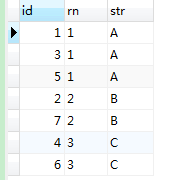关键字:mysql实现开窗函数、Mysql实现分析函数、利用变量实现窗口函数
注意,变量是从左到右顺序执行的
--测试数据 CREATE TABLE `tem` ( `id` int(11) NOT NULL AUTO_INCREMENT, `str` char(1) DEFAULT NULL, PRIMARY KEY (`id`) ) ENGINE=InnoDB AUTO_INCREMENT=9 DEFAULT CHARSET=utf8; INSERT INTO `test`.`tem`(`id`, `str`) VALUES (1, 'A'); INSERT INTO `test`.`tem`(`id`, `str`) VALUES (2, 'B'); INSERT INTO `test`.`tem`(`id`, `str`) VALUES (3, 'A'); INSERT INTO `test`.`tem`(`id`, `str`) VALUES (4, 'C'); INSERT INTO `test`.`tem`(`id`, `str`) VALUES (5, 'A'); INSERT INTO `test`.`tem`(`id`, `str`) VALUES (6, 'C'); INSERT INTO `test`.`tem`(`id`, `str`) VALUES (7, 'B');
--1.row_number() over(order by )
变量会最后再计算,索引是先排序好之后,才会开始计算@num
SELECT @num := @num+1 num, id, str FROM tem, (SELECT @str := '', @num := 0) t1 ORDER BY str, id;
--2、实现分组排名效果(row_number() over(partition by order by ))
--变量方式
SELECT @num := IF(@str = str, @num + 1, 1) num, id, @str := str str FROM tem, (SELECT @str := '', @num := 0) t1 ORDER BY str, id;
--子查询方式【取分组中前N行(排名前几名)】
mysql 相关子查询参考
select * from testGroup as a where a.ID in (select ID from testGroup b where a.UserID = b.UserID order by b.OrderID limit 2) --或者 select * from testGroup a where not exists (select 1 from testGroup b where a.UserID = b.UserID and a.OrderID > b.OrderID having count(1) >= 2) --或者 select * from testGroup a where (select count(1) from testGroup b where a.UserID = b.UserID and a.ID >= b.ID) <= 2 --没有唯一标识的表,可以用checksum来标识每行(MSSQL?) select * from testGroup as a where checksum(*) in (select top 2 checksum(*) from testGroup b where a.UserID = b.UserID order by b.OrderID)
mysql使用子查询实现
create table test1_1(id int auto_increment primary key,`subject` char(20),score int); insert into test1_1 values(null,'语文',99),(null,'语文',98),(null,'语文',97); insert into test1_1 values(null,'数学',89),(null,'数学',88),(null,'数学',87); insert into test1_1 values(null,'英语',79),(null,'英语',78),(null,'英语',77); -- 根据成绩,求出每个科目的前2名 select * from test1_1; select * from test1_1 t1 where (select count(1) from test1_1 t2 where t1.subject=t2.subject and t2.score>=t1.score ) <=2;
-- 查询结果【左边】原表内容 【右边】需求结果,根据成绩,求出每个科目的前2名
![]()
--3、实现dense_rank() over(order by)
--变量会最后再计算,所以是先排序好之后,才会开始计算@num
select id,@num:=IF(@STR=STR,@num,@num+1) rn,@str:=str str from tem t1,(select @str:='',@num:=0) t2 order by str
--

---case when 形式,但该方法在mysql5.5中,只支持非0数字排序生成,字符会有大问题(任意字符被case when 'a' then else end,都会走else)
--且,赋值语句等于0时也为假
--错误的方式 select id,str, case when @str=str then @num when @str:=str then @num:=@num+1 end as 'rn' from tem t1,(select @str:='',@num:=1) t2 order by str

--正确的方式 select id,str, case when @str=str then @num when @str:=str then @num:=@num+1 else @num:=@num+1 end as 'rn' from tem t1,(select @str:='',@num:=0) t2 order by str
--关于数字的case when 验证
关于字符、字符串 的case when验证

---------------------
数据大部分引用自:https://blog.csdn.net/mingqing6364/article/details/82621840
来源:CSDN


